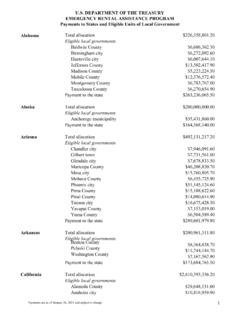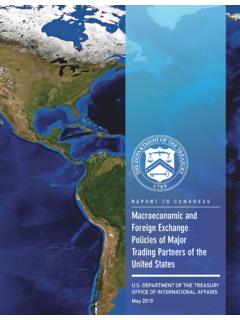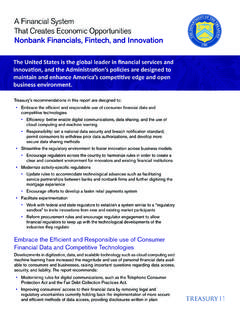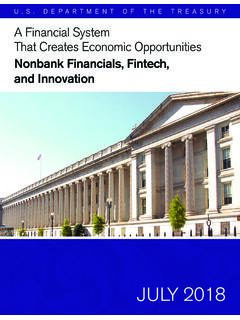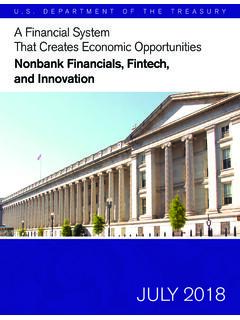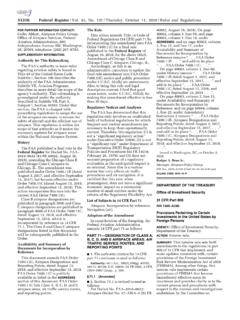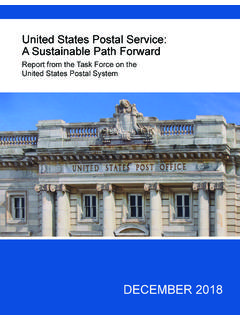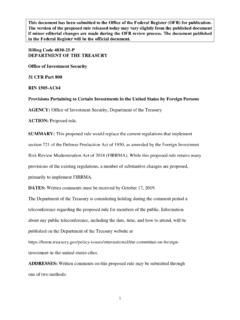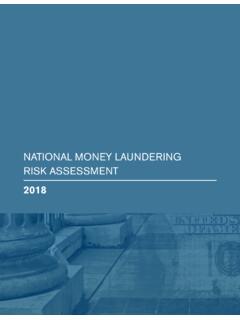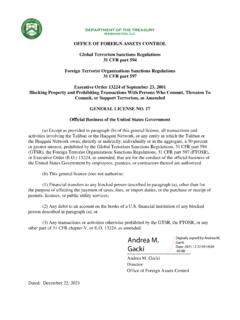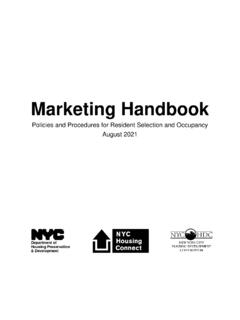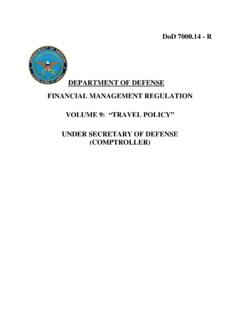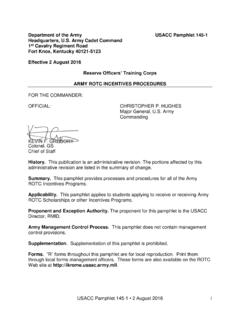Transcription of U.S. Department of the Treasury Emergency Rental ...
1 1 Department of the Treasury Emergency Rental Assistance Frequently Asked Questions Revised August 25, 2021 The Department of the Treasury ( Treasury ) is providing these frequently asked questions (FAQs) as guidance regarding the requirements of the Emergency Rental Assistance program (ERA1) established by section 501 of Division N of the Consolidated Appropriations Act, 2021, Pub. L. No. 116-260 (Dec. 27, 2020) and the Emergency Rental Assistance program (ERA2) established by section 3201 of the American Rescue Plan Act of 2021, Pub. L. No. 117-2 (March 11, 2021). These FAQs apply to both ERA1 and ERA2, except where differences are specifically noted.
2 References in these FAQs to the ERA apply to both ERA1 and ERA2. These FAQs will be supplemented by additional Grantees must establish policies and procedures to govern the implementation of their ERA programs consistent with the statutes and these FAQs. To the extent that these FAQs do not provide specific guidance on a particular issue, a grantee should establish its own policy or procedure that is consistent with the statutes and follow it consistently. 1. Who is eligible to receive assistance in the ERA and how should a grantee document the eligibility of a household? A grantee may only use the funds provided in the ERA to provide financial assistance and housing stability services to eligible households.
3 To be eligible, a household must be obligated to pay rent on a residential dwelling and the grantee must determine that: i. for ERA1: a. one or more individuals within the household has qualified for unemployment benefits or experienced a reduction in household income, incurred significant costs, or experienced other financial hardship due, directly or indirectly, to the COVID-19 outbreak; b. one or more individuals within the household can demonstrate a risk of experiencing homelessness or housing instability; and 1 On January 19, 2021, initial FAQs were released for ERA1. On February 22, 2021, the initial FAQs were revised to, among other things, clarify program requirements and provide additional flexibility with respect to documenting the eligibility of households.
4 On March 16, 2021, FAQ 7 was revised to add Rental security deposits as a permissible relocation expense and clarify that application or screening fees are permissible Rental fees and FAQs 26 28 were added. On March 25, 2021, FAQ 29 was added. On May 7, 2021, these FAQs were revised to provide initial guidance for ERA2, to clarify differences between ERA1 and ERA2, and to clarify how ERA should be used to promote housing stability for eligible households. On June 24, 2021, these FAQs were revised to further clarify how to promote housing stability for eligible households; specifically, FAQs 14, 23, 31, 33, and 35 were revised and FAQs 36 39 were added, in addition to other non-substantive changes.
5 On August 25, 2021, these FAQs were revised to provide further clarification on the use of self-attestation and to describe methods of speeding payments to eligible households. Specifically, substantive revisions were made to FAQs 3, 4, 7, 11, and 38; FAQs 40-42 were added; and additional edits were made for clarity. 2 c. the household has a household income at or below 80 percent of area median income. ii. for ERA2: a. one or more individuals within the household has qualified for unemployment benefits or experienced a reduction in household income, incurred significant costs, or experienced other financial hardship during or due, directly or indirectly, to the coronavirus pandemic; b.
6 One or more individuals within the household can demonstrate a risk of experiencing homelessness or housing instability; and c. the household is a low-income family (as such term is defined in section 3(b) of the United States Housing Act of 1937 (42 1437a(b))).2 While there are some differences in eligibility between ERA1 and ERA2, the eligibility requirements are very similar, and Treasury is seeking to implement ERA2 consistently with ERA1, to the extent possible, to reduce administrative burdens for grantees. The FAQs below describe the documentation requirements for each of these conditions of eligibility. These requirements provide for various means of documentation so that grantees may extend this Emergency assistance to vulnerable populations without imposing undue documentation burdens.
7 As described below, given the challenges presented by the COVID-19 pandemic, grantees may be flexible as to the particular form of documentation they require, including by permitting photocopies or digital photographs of documents, e-mails, or attestations from employers, landlords, caseworkers, or others with knowledge of the household s circumstances. Treasury strongly encourages grantees to avoid establishing documentation requirements that are likely to be barriers to participation for eligible households, including those with irregular incomes such as those operating small business or gig workers whose income is reported on Internal Revenue Service Form 1099.
8 However, grantees must require all applications for assistance to include an attestation from the applicant that all information included is correct and complete. In all cases, grantees must document their policies and procedures for determining a household s eligibility to include policies and procedures for determining the prioritization of households in compliance with the statute and maintain records of their determinations. Grantees must also have controls in place to ensure compliance with their policies and procedures and prevent fraud. Grantees must specify in their policies and procedures under what circumstances they will accept written attestations from the applicant without further documentation to determine any aspect of 2 As of the date of these FAQs, the definition of low-income families in 42 1437a(b)
9 Is those families whose incomes do not exceed 80 per centum of the median income for the area, as determined by the Secretary [of Housing and Urban Development] with adjustments for smaller and larger families, except that the Secretary may establish income ceilings higher or lower than 80 per centum of the median for the area on the basis of the Secretary s findings that such variations are necessary because of prevailing levels of construction costs or unusually high or low family incomes. 3 eligibility or the amount of assistance, and in such cases, grantees must have in place reasonable validation or fraud-prevention procedures to prevent abuse.
10 2. How should applicants document that a member of the household has qualified for unemployment benefits, experienced a reduction in income, incurred significant costs, or experienced other financial hardship during or due to the COVID-19 outbreak? A grantee must document that one or more members of the applicant s household either (i) qualified for unemployment benefits; or (ii) (a) for ERA1, experienced a reduction in household income, incurred significant costs, or experienced other financial hardship due, directly or indirectly, to the COVID-19 outbreak or (b) for ERA2, experienced a reduction in household income, incurred significant costs, or experienced other financial hardship during or due, directly or indirectly, to the coronavirus If the grantee is relying on clause (i) for this determination, or if the grantee is relying on clause (ii)
